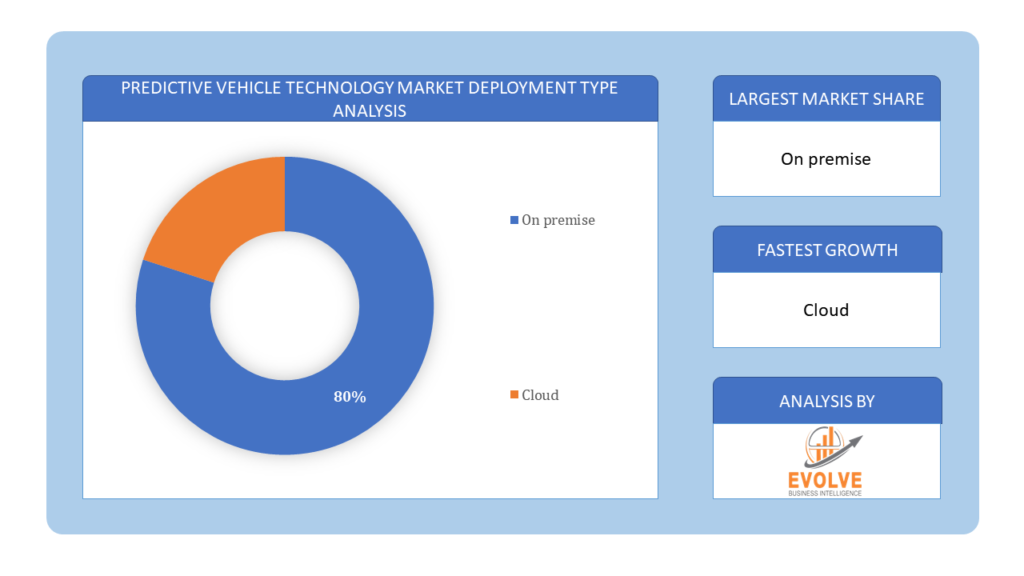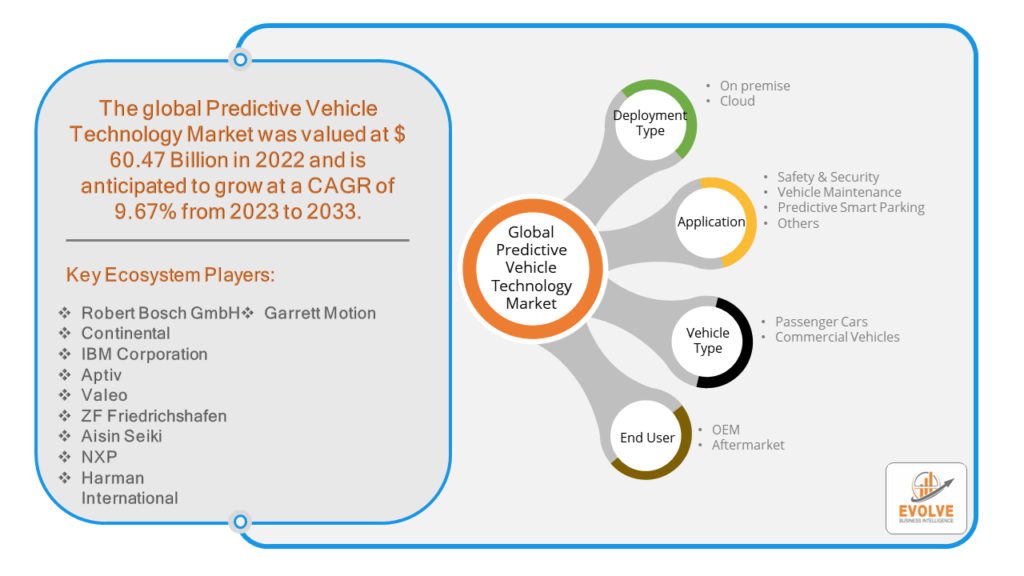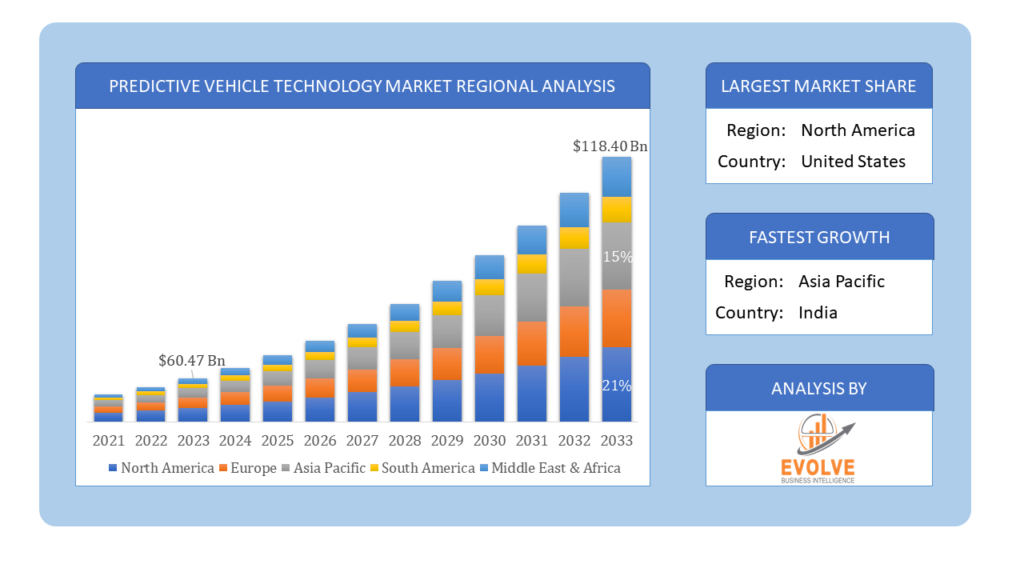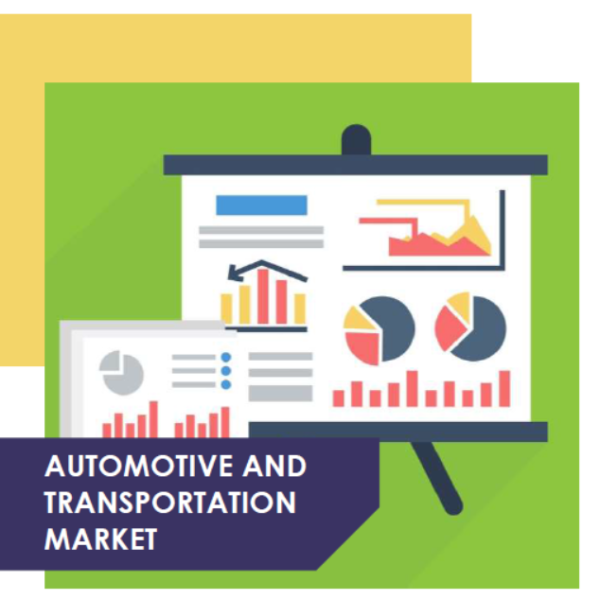Global Predictive Vehicle Technology Market Overview
The Global Predictive Vehicle Technology Market Size is expected to reach USD 118.40 Billion by 2033. The Global Predictive Vehicle Technology Market industry size accounted for USD 60.47 Billion in 2023 and is expected to expand at a compound annual growth rate (CAGR) of 9.67% from 2023 to 2033. The Global Predictive Vehicle Technology Market refers to the collective market for technologies that enable vehicles to anticipate and respond to various situations, conditions, and user preferences through data analysis and predictive algorithms.
Advanced driver assistance systems (ADAS) that use predictive algorithms to anticipate driver behavior, road conditions, and traffic patterns to provide proactive assistance, such as adaptive cruise control, lane-keeping assistance, and predictive braking. The Global Predictive Vehicle Technology Market is driven by factors such as increasing demand for connected and autonomous vehicles, advancements in sensor technology and data analytics, growing focus on road safety and efficiency, and regulatory initiatives promoting the adoption of advanced driver assistance systems.
Global Predictive Vehicle Technology Market Synopsis
The COVID-19 pandemic had Significant impacts on the Global Predictive Vehicle Technology Market. The pandemic disrupted global supply chains, leading to shortages of components and delays in manufacturing processes for automotive technologies, including predictive vehicle technology. This resulted in delays in Product launches and installations. During the initial phases of the pandemic, many countries implemented lockdown measures, leading to a significant decline in automotive sales. This reduced demand for new vehicles, including those equipped with predictive vehicle technology systems. Economic uncertainties and changes in consumer behavior during the pandemic led to a shift in priorities for many consumers. While safety features like predictive collision avoidance remained important, there was a potential slowdown in the adoption of other predictive vehicle technologies as consumers focused more on essential needs. The economic impact of the pandemic prompted automotive manufacturers to focus on cost optimization and prioritization of investments. This may have resulted in a slowdown in the development and deployment of certain predictive vehicle technology solutions that were not deemed essential in the short term.
Global Predictive Vehicle Technology Market Dynamics
The major factors that have impacted the growth of Global Predictive Vehicle Technology Market are as follows:
Drivers:
Ø Advancements in Sensor Technology:
Continuous advancements in sensor technology, including radar, lidar, cameras, and other IoT devices, are enabling vehicles to capture and process vast amounts of data. These sensors provide critical inputs for predictive algorithms, enhancing vehicle safety, efficiency, and performance. Predictive maintenance solutions are gaining traction as they offer significant cost savings and operational efficiencies for fleet operators and automotive manufacturers. By leveraging data analytics and machine learning algorithms, predictive maintenance systems can anticipate component failures before they occur, reducing downtime and maintenance costs. The rapid pace of technological innovation, particularly in areas such as artificial intelligence (AI), machine learning, and big data analytics, is driving the development of more sophisticated predictive vehicle technology solutions. These innovations enable vehicles to analyze complex data sets and make real-time decisions, paving the way for highly intelligent and autonomous vehicles.
Restraint:
- Perception of High Initial Investment Costs
The implementation of predictive vehicle technology often requires significant upfront investment in research, development, and infrastructure. For automakers, fleet operators, and suppliers, the initial costs associated with integrating predictive technology into vehicles and systems can be a barrier to adoption. Predictive vehicle technology relies heavily on collecting and analyzing large volumes of data from sensors, cameras, and other sources. Ensuring the privacy and security of this data is paramount, as any breaches or misuse could lead to serious consequences, including regulatory fines, reputational damage, and legal liabilities.
Opportunity:
⮚ Focus on Predictive Maintenance and Fleet Management
The growing emphasis on predictive maintenance and fleet management presents opportunities for predictive vehicle technology providers. By leveraging data analytics and machine learning algorithms, predictive maintenance systems can help fleet operators optimize vehicle uptime, reduce maintenance costs, and enhance operational efficiency. Predictive vehicle technology can play a key role in smart city initiatives aimed at improving urban mobility and reducing congestion. By integrating with smart city infrastructure and transportation systems, predictive analytics can enable more efficient traffic management, optimized parking, and enhanced public transportation services. Predictive vehicle technology offers opportunities to enhance the user experience and personalize in-vehicle services. By analyzing driver behavior, preferences, and contextual data, predictive analytics can deliver personalized recommendations, adaptive infotainment, and proactive assistance, tailored to individual users.
Global Predictive Vehicle Technology Market Segment Overview
By Deployment Type
 Based on Deployment Type, the market is segmented based on On premise and Cloud. The On-Premise segment is dominant the market. The growing need for different applications like parking management and pollution analytics is also helping to propel the industry forward. The need for predictive software and services is growing in response to the growing need to improve driver efficiency while also lowering operating costs.
Based on Deployment Type, the market is segmented based on On premise and Cloud. The On-Premise segment is dominant the market. The growing need for different applications like parking management and pollution analytics is also helping to propel the industry forward. The need for predictive software and services is growing in response to the growing need to improve driver efficiency while also lowering operating costs.
By Application
Based on Application, the market segment has been divided into the Safety & Security, Vehicle Maintenance, Predictive Smart Parking and Others. The Safety & Security segment is anticipated to dominant the market. These systems utilize predictive analytics and sensor data to anticipate potential collisions and take preemptive actions to avoid accidents. They may include features such as forward collision warning, automatic emergency braking, pedestrian detection, and blind-spot monitoring, among others.
By Vehicle Type
Based on Vehicle Type, the market segment has been divided into the Passenger Cars and Commercial Vehicles. The Passenger Cars segment is anticipated to dominant the market. Due to rising passenger car sales throughout the world, the passenger car sector is expected to lead the vehicle type segment over the projection period. The segment’s expansion is being fueled by customers increased disposable income throughout the world. Consumer demand for electric vehicles is expanding, and the government has set many regulations on vehicle emissions, which is propelling the sector forward. The market’s growth is being aided by increased environmental concerns as a result of rising carbon footprints.
By End User
Based on End User, the market segment has been divided into the OEM and Aftermarket. The OEM segment is dominant the market. OEMs are responsible for integrating predictive vehicle technology into new vehicles during the manufacturing process. This includes incorporating sensors, cameras, computing systems, and software algorithms that enable predictive features such as collision avoidance, adaptive cruise control, predictive maintenance, and driver assistance systems.
Global Predictive Vehicle Technology Market Regional Analysis
Based on region, the global Predictive Vehicle Technology Market has been divided into North America, Europe, Asia-Pacific, the Middle East & Africa, and Latin America. North America is projected to dominate the use of the Global Predictive Vehicle Technology Market followed by the Asia-Pacific and Europe regions.
 Predictive Vehicle Technology North America Market
Predictive Vehicle Technology North America Market
North America holds a dominant position in the Global Predictive Vehicle Technology Market. North America is a leading market for predictive vehicle technology, driven by the presence of prominent automotive manufacturers, technological innovation hubs, and a strong focus on safety and regulatory compliance. The region’s advanced infrastructure, favorable regulatory environment, and high adoption rates of connected and autonomous vehicles contribute to market growth. Key players in North America include the United States and Canada.
Predictive Vehicle Technology Asia-Pacific Market
The Asia-Pacific region has indeed emerged as the fastest-growing market for the Global Predictive Vehicle Technology Market industry. The Asia-Pacific region is experiencing rapid growth in the predictive vehicle technology market, driven by the presence of key automotive manufacturing hubs, increasing consumer demand for advanced vehicle features, and government initiatives to promote smart mobility solutions. China, Japan, South Korea, and India are key markets in the Asia-Pacific region, with significant investments in autonomous driving, electric vehicles, and smart transportation infrastructure.
Competitive Landscape
The global Predictive Vehicle Technology Market is highly competitive, with numerous players offering a wide range of software solutions. The competitive landscape is characterized by the presence of established companies, as well as emerging startups and niche players. To increase their market position and attract a wide consumer base, the businesses are employing various strategies, such as Product launches, and strategic alliances.
Prominent Players:
- Robert Bosch GmbH
- Continental
- IBM Corporation
- Aptiv
- Valeo
- ZF Friedrichshafen
- Aisin Seiki
- NXP
- Harman International
- Garrett Motion
Scope of the Report
Global Predictive Vehicle Technology Market, by Deployment Type
- On premise
- Cloud
Global Predictive Vehicle Technology Market, by Application
- Safety & Security
- Vehicle Maintenance
- Predictive Smart Parking
- Others
Global Predictive Vehicle Technology Market, by Vehicle Type
- Passenger Cars
- Commercial Vehicles
Global Predictive Vehicle Technology Market, by End User
- OEM
- Aftermarket
Global Predictive Vehicle Technology Market, by Region
- North America
- US
- Canada
- Mexico
- Europe
- UK
- Germany
- France
- Italy
- Spain
- Benelux
- Nordic
- Rest of Europe
- Asia Pacific
- China
- Japan
- South Korea
- Indonesia
- Austalia
- Malaysia
- India
- Rest of Asia Pacific
- South America
- Brazil
- Argentina
- Rest of South America
- Middle East & Africa
- Saudi Arabia
- UAE
- Egypt
- South Africa
- Rest of Middle East & Africa
| Parameters | Indicators |
|---|---|
| Market Size | 2033: $118.40 Billion |
| CAGR | 9.67% CAGR (2023-2033) |
| Base year | 2022 |
| Forecast Period | 2023-2033 |
| Historical Data | 2021 |
| Report Coverage | Revenue Forecast, Competitive Landscape, Growth Factors, and Trends |
| Key Segmentations | Deployment Type, Application, Vehicle Type, End User |
| Geographies Covered | North America, Europe, Asia-Pacific, Latin America, Middle East, Africa |
| Key Vendors | Robert Bosch GmbH, Continental, IBM Corporation, Aptiv, Valeo, ZF Friedrichshafen, Aisin Seiki, NXP, Harman International and Garrett Motion |
| Key Market Opportunities | • Focus on Predictive Maintenance and Fleet Management • Enhanced User Experience and Personalization |
| Key Market Drivers | • Advancements in Sensor Technology • Growing Emphasis on Predictive Maintenance |
REPORT CONTENT BRIEF:
- High-level analysis of the current and future Global Predictive Vehicle Technology Market trends and opportunities
- Detailed analysis of current market drivers, restraining factors, and opportunities in the future
- Global Predictive Vehicle Technology Market historical market size for the year 2021, and forecast from 2023 to 2033
- Global Predictive Vehicle Technology Market share analysis at each product level
- Competitor analysis with detailed insight into its product segment, Government & Defense strength, and strategies adopted.
- Identifies key strategies adopted including product launches and developments, mergers and acquisitions, joint ventures, collaborations, and partnerships as well as funding taken and investment done, among others.
- To identify and understand the various factors involved in the global Predictive Vehicle Technology Market affected by the pandemic
- To provide a detailed insight into the major companies operating in the market. The profiling will include the Government & Defense health of the company’s past 2-3 years with segmental and regional revenue breakup, product offering, recent developments, SWOT analysis, and key strategies.







